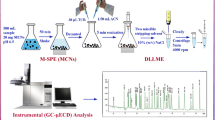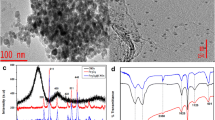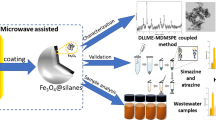Abstract
In this work, a highly sensitive solid-phase-dispersive microextraction method was designed based on magnetic carbon nanocomposites as a magnetic solid-phase extraction sorbent coupled with dispersive liquid–liquid microextraction and two miscible stripping solvents (MSPE–DLLME) followed by gas chromatography–mass spectrometry (GC–MS) for determination of 16 polycyclic aromatic hydrocarbons (PAHs). By adopting this research methodology, a mixture of two miscible organic solvents is used not only as stripping solvent for MSPE, but also as extraction and disperser solvents for DLLME procedure. Several parameters such as amount of extraction adsorbent, type of stripping, extraction solvents and their volumes, salt effect, and pH and volume of sample solution were optimized to obtain high extraction recoveries. Finally, 2 µL of extraction phase was injected into GC–MS. Under optimal conditions, the method attained satisfactory precisions (RSD% ≤ 8.66), excellent limits of detection in the range of 0.1–0.5 ng kg−1 at S/N = 3, and very high enrichment factors in the range of 28,187–33,149 for 500 mL sample solution of different PAHs. The calibration curves of 16 extracted PAHs were linear in the range of 0.4–10,000 ng kg−1, with coefficients of determination (r2) between 0.9989 and 0.9999. The optimized method to determine 16 PAHs has been successfully applied in the real environment including waters, waste water, sewage, and soil.
Graphical Abstract






Similar content being viewed by others
References
Sun F, Littlejohn D, Mark DG (1998) Ultrasonication extraction and solid phase extraction clean-up for determination of US EPA 16 priority pollutant polycyclic aromatic hydrocarbons in soils by reversed-phase liquid chromatography with ultraviolet absorption detection. Anal Chim Acta 364:1–11
Ma J, Xiao R, Li J, Yu J, Zhang Y, Chenb L (2010) Determination of 16 polycyclic aromatic hydrocarbons in environmental water samples by solid-phase extraction using multi-walled carbon nanotubes as adsorbent coupled with gas chromatography–mass spectrometry. J Chromatogr A 1217:5462–5469
Bernal J, Nozal M, Toribio L, Serna M, Borrull F, Marc R (1997) Determination of polycyclic aromatic hydrocarbons in waters by use of supercritical fluid chromatography coupled on-line to solid-phase extraction with disks. Jf Chromatogr A 778:321–328
Filipkowska A, Ludwik L, Grazyna K (2005) Polycyclic aromatic hydrocarbon analysis in different matrices of the marine environmen. Anal Chim Acta 547:243–254
Fladung NC (1995) Optimization of automated solid-phase extraction for quantitation of polycyclic aromatic hydrocarbons in aqueous media by high-performance liquid chromatography–UV detection. J Chromatogr A 692:21–26
Rahimi M, Noroozian E (2014) Frits coated with nano-structured conducting copolymer for solid-phase extraction of polycyclic aromatic hydrocarbons in water samples and liquid chromatographic analysis. Talanta 123:224–232
Shariati-Feizabadi S, Yamini Y, Bahramifar N (2003) Headspace solvent microextraction and gas chromatographic determination of some polycyclic aromatic hydrocarbons in water samples. Anal Chim Acta 489:21–31
Han Q, Wang Z, Xia J, Chen S, Zhang X, Ding M (2012) Facile and tunable fabrication of Fe3O4/graphene oxide nanocomposites and their application in the magnetic solid-phase extraction of polycyclic aromatic hydrocarbons from environmental water samples. Talanta 101:388–395
Liu X, Lu X, Huang Y, Liu C, Zhao S (2014) Fe3O4@ionic liquid@methyl orange nanoparticles as a novel nano-adsorbent for magnetic solid-phase extraction of polycyclic aromatic hydrocarbons in environmental water samples. Talanta 119:341–347
Reyes-Gallardo EM, Lucena R, Cárdenas S, Valcárcel M (2014) Magnetic nanoparticles-nylon 6 composite for the dispersive micro solid phase extraction of selected polycyclic aromatic hydrocarbons from water samples. J Chromatogr A 1345:43–49
Yang N, Zhu S, Zhang D, Xu S (2008) Synthesis and properties of magnetic Fe3O4-activated carbon nanocomposite particles for dye removal. Mater Lett 62:645–657
Yazdanfar N, Yamini Y, Ghambarian M (2014) Homogeneous liquid–liquid microextraction for determination of organochlorine pesticides in water and fruit samples. Chromatographia 77:329–336
Kamankesh M, Mohammadi A, Hosseini H, Modarres Tehrani Z (2015) Rapid determination of polycyclic aromatic hydrocarbons in grilled meat using microwave-assisted extraction and dispersive liquid–liquid microextraction coupled to gas chromatography–mass spectrometry. Meat Sci 103:61–67
Tseng W, Chen P, Huang S (2014) Optimization of two different dispersive liquid–liquid microextraction methods followed by gas chromatography–mass spectrometry determination for polycyclic aromatic hydrocarbons (PAHs) analysis in water. Talanta 120:425–432
Fernández M, Clavijo S, Forteza R, Cerdà V (2015) Determination of polycyclic aromatic hydrocarbons using lab on valve dispersive liquid–liquid microextraction coupled to high performance chromatography. Talanta 138:190–195
Khalili Zanjani MR, Yamini Y, Shariati S, Jonsson JA (2007) A new liquid-phase microextraction method based on solidification of floating organic drop. Anal Chim Acta 585:286–293
Saleh A, Yamini Y, Faraji M, Rezaee M, Ghambarian M (2009) Ultrasound-assisted emulsification microextraction method based on applying low density organic solvents followed by gas chromatography analysis for the determination of polycyclic aromatic hydrocarbons in water samples. J Chromatogr A 1216:6673–6679
Kolahgar B, Hoffmann A, Heiden AC (2002) Application of stir bar sorptive extraction to the determination of polycyclic aromatic hydrocarbons in aqueous samples. J Chromatogr A 963:225–230
Peter P, Bauer C, Wennrich L (2001) Application of stir bar sorptive extraction in combination with column liquid chromatography for the determination of polycyclic aromatic hydrocarbons in water samples. Anal Chim Acta 436:1–9
Doong R, Chang S, Sun Y (2000) Solid-phase microextraction for determining the distribution of sixteen US Environmental Protection Agency polycyclic aromatic hydrocarbons in water samples. J Chromatogr A 879:177–188
Zuazagoitia D, Millán E, Garcia R (2007) A screening method for polycyclic aromatic hydrocarbons determination in water by headspace SPME with GC–FID. Chromatographia 66:773–777
Charalabaki M, Psillakis E, Kalogerakis N, Mantzavinos D (2005) Analysis of polycyclic aromatic hydrocarbons in wastewater treatment plant effluents using hollow fibre liquid-phase microextraction. Chemosphere 60:690–698
Cacho JI, Campillo N, Viñas P, Hernández-Córdoba M (2014) Use of headspace sorptive extraction coupled to gas chromatography–mass spectrometry for the analysis of volatile polycyclic aromatic hydrocarbons in herbal infusions. J Chromatogr A 1356:38–44
Shamsipur M, Yazdanfar N, Ghambarian M (2016) Combination of solid-phase extraction with dispersive liquid–liquid microextraction followed by GC–MS for determination of pesticide residues from water, milk, honey and fruit juice. Food Chem 204:289–297
Mehdinia A, Khojasteh E, Baradaran Kayyal T, Jabbari A (2014) Magnetic solid phase extraction using gold immobilized magnetic mesoporous silica nanoparticles coupled with dispersive liquid–liquid microextraction for determination of polycyclic aromatic hydrocarbons. J Chromatogr A 1364:20–27
López-Jiménez F, Ballesteros-Gómez A, Rubio S (2014) Determination of polycyclic aromatic hydrocarbons (PAH4) in food by vesicular supramolecular solvent-based microextraction and LC–fluorescence detection. Food Chem 143:341–347
Aragón Á, Toledano R, Vázquez A, Villén J, Cortés J (2015) Analysis of polycyclic aromatic hydrocarbons in aqueous samples by large volume injection gas chromatography–mass spectrometry using the through oven transfer adsorption desorption interface. Talanta 139:1–5
Pincemaille J, Schummer C, Heinen E, Moris G (2014) Determination of polycyclic aromatic hydrocarbons in smoked and non-smoked black teas and tea infusions. Food Chem 145:807–813
Tajabadi F, Yamini Y, Sovizi MR (2013) Carbon-based magnetic nanocomposites in solid phase dispersion for the preconcentration some of lanthanides, followed by their quantitation via ICP-OES. Microchim Acta 180:65–73
Guo L, Kee Lee H (2011) Low-density solvent-based solvent demulsification dispersive liquid–liquid microextraction for the fast determination of trace levels of sixteen priority polycyclic aromatic hydrocarbons in environmental water samples. J Chromatogr A 1218:5040–5046
Rezaee M, Assadi Y, Milani Hosseini MR, Aghaee E, Ahmadia F, Berijani S (2006) Determination of organic compounds in water using dispersive liquid–liquid microextraction. J Chromatogr A 1116:1–9
Simpson SA, Burston LB, Jolley DF, Chau K (2006) Application of surrogate methods for assessing the bioavailability of PAHs in sediments to a sediment ingesting bivalve. Chemosphere 65:2401–2410
Acknowledgements
The authors greatly appreciate the support of this work by the Research Councils of Razi University and Iranian Research and Development Center for Chemical Industries and Iran National Elite Foundation (INEF).
Author information
Authors and Affiliations
Corresponding author
Ethics declarations
Conflict of interest
The authors declare that they have no conflict of interest.
Ethical approval
This article does not contain any studies with human or animal subjects.
Informed consent
Informed consent was not applicable.
Rights and permissions
About this article
Cite this article
Yazdanfar, N., Shamsipur, M., Ghambarian, M. et al. A Highly Sensitive Dispersive Microextraction Method with Magnetic Carbon Nanocomposites Coupled with Dispersive Liquid–Liquid Microextraction and Two Miscible Stripping Solvents Followed by GC–MS for Quantification of 16 PAHs in Environmental Samples. Chromatographia 81, 487–499 (2018). https://doi.org/10.1007/s10337-018-3469-5
Received:
Revised:
Accepted:
Published:
Issue Date:
DOI: https://doi.org/10.1007/s10337-018-3469-5




